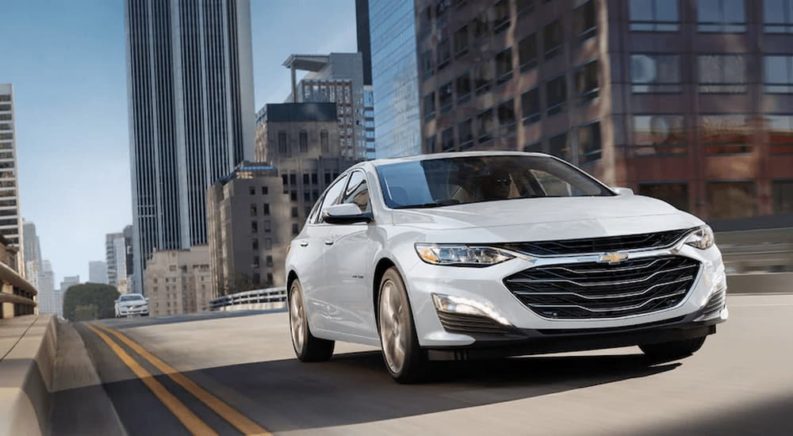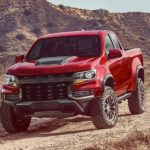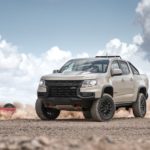Today, drivers demand more from their vehicles regarding capability but without compromising efficiency or handling. We want exceptional road warriors that are engaging and fun to drive, but they also need to be capable and efficient so that we don’t spend a fortune on fuel or aren’t tied to charging stations for long periods. We want our cake, and we want to eat it, too.
Automakers are expected to deliver, and they have. Crossovers now offer sedan-like handling and modestly sip fuel, while full-size SUVs run on hybrid powertrains and trucks boast all-electric power plants that churn out more horsepower and capability than expected. The increased efficiency and practicality of larger vehicles have led consumers to turn away from cars like the 2023 Chevy Malibu, one of the few remaining sedans in an industry defined by the “bigger is always better” mentality.
The Malibu is one of Chevrolet’s longest-running nameplates, progressing from a rear-wheel drive hot rod to the reliable sedan we know today. Its evolution is remarkable because it reflects how attuned Chevrolet is to driver needs and industry trends. While other automakers have abandoned ship by exchanging their sedans for SUVs, Chevrolet has kept the Malibu in its lineup to give drivers a reliable alternative to the Honda Accord and Toyota Camry. Drivers have responded in kind, but why? What makes the Malibu so integral to the Chevy lineup and such a popular choice?
What It Was: The Malibu Hot Rod Era
Muscle cars ruled the road in 1960s America, with Chevrolet entering the competition with models like the 1964 Chevelle Malibu. The Malibu designated the Chevelle’s top-tier, performance-oriented trim with the SS performance package transforming the car into a hot rod worthy of the era. Only offered on two-door models, the Malibu SS made a lasting impression with its iconic design and a potent 300-hp engine. However, the Malibu was far from the fastest and most stylish in the segment.
The Malibu’s first few years as part of the Chevelle lineup saw a progression of power and performance improvements. Chevy updated its 327 cubic-inch V8 to deliver 350 hp and even manufactured a few hundred Malibu SS models with a modified chassis and a 396 cubic-inch V8 engine that produced 375 hp. The Malibu’s evolution continued into the 1970s when, after several redesigns, the Malibu finally earned its place in the muscle car era.
Chevy guaranteed as much by outfitting the 1970 Chevelle Malibu SS with a big-block V8 capable of producing 450 hp and 500 lb-ft of torque. With a launch from 0 to 60 mph in under six seconds, the Chevelle Malibu SS set its sights on the track and entered the NASCAR circuit in the early 1970s. The Malibu’s 10-year run on the track earned it over two dozen appearances in the winner’s circle and ultimately marked the end of an era. Chevrolet discontinued the model in 1983, but the Malibu was not forgotten.
What It Is Today: The Malibu Transformation
The rear-wheel drive V8 Malibu made a lasting impression in America in the 1960s and 1970s, but growing fuel economy standards made it difficult for the Malibu to keep its place in the spotlight. Discontinued in 1983, the Malibu spent the next 14 years as a memory until its grand return in an era defined by front-wheel drive sedans that blended luxury with performance and affordability. The biggest question at the time was how the Malibu would live up to its legacy.
The Malibu’s next chapter began in 1997 when it returned to the Chevy lineup as a front-wheel drive sedan. Slated against models like the Toyota Camry and Honda Accord, the Malibu’s return was met with mixed reviews. Motor Trend named it the 1997 Car of the Year, but others panned its design and performance. After all, its 150-hp four-cylinder engine and inoffensive looks were a far cry from the big-block V8 of decades past.
Despite mixed reviews, the Malibu continued to evolve in the Chevy lineup, focusing less on performance and more on comfort and efficiency. We see this in the new millennium when the Malibu’s standard powertrain shrank again to a 2.2L with 144 hp on the 2004 models. Fortunately, the tides turned in 2006 when Chevy outfitted a new Malibu SS with a 240-hp 3.9L V6, keeping the car’s legacy of performance alive in a more efficient form.
Fast forward nearly two decades, and the Malibu stands alone in Chevy’s sedan lineup. The 2023 Malibu boasts the reliability and dependability of the Chevy name, but it’s shed its skin as a former hot rod. It now relies on a 1.5L turbocharged four-cylinder to deliver 160 hp, 184 lb-ft of torque, and a rated fuel economy of 27 MPG in the city and 35 MPG on the highway. Efficiency has taken the place of power and performance, but that may not be entirely a bad thing.
Why It Works in the Current Landscape
Some argue that the 2023 Malibu’s declining power output is the final nail in its coffin. However, there’s something else to consider: the current landscape. Drivers old enough to appreciate the Malibu’s history as a hot rod aren’t flocking to Chevrolet dealerships to buy this sedan. Instead, those drivers are well-established enough to enjoy retirement from behind the wheel of more legendary muscle cars like the Corvette and Camaro.
Drivers looking for the Malibu recognize it as an efficient sedan that makes luxury accessible and allows them to upgrade their commutes without going over budget. In addition, the Malibu is renowned for offering the latest technologies and a dynamic driving experience, especially models built since the 2019 refresh. Likewise, its exclusivity as one of the few sedans in the segment adds to its appeal, which is only heightened by Chevrolet’s stellar reputation.
The Malibu’s sales numbers prove as much, with over 115,000 units sold in 2022. That makes the aging Malibu the third best-seller in the entire Chevy lineup, behind only the Silverado and the Equinox. Despite the car’s age, 2023 models offer wireless smartphone integration, LED headlights, heated front seats, navigation, smartphone integration, and an expansive suite of driver-assist features. With the 2023 model starting at just $25,000, the Malibu is a deal many drivers can’t ignore.
Rumors of the Future
The dwindling number of sedans in the industry has left many to assume that the Malibu will soon face the chopping block, with industry watchers predicting its discontinuation in 2024. However, new rumors now suggest the next generation Malibu will debut in 2025, breathing fresh life into this Chevy classic. Now, the question is whether or not the Malibu will embody Chevrolet’s vision for an all-electric future and eventually join the Ultium family.
For now, we can only wait and speculate as Chevy is playing its cards close to its chest. With more states promising a ban on internal combustion cars over the next decade, the Malibu’s future remains in the air. Will we see it return for its next generation as a mildly-updated efficient commuter? Or will it debut as an all-electric sedan that delivers instantaneous power and dynamic performance that recalls its V8 predecessors?





